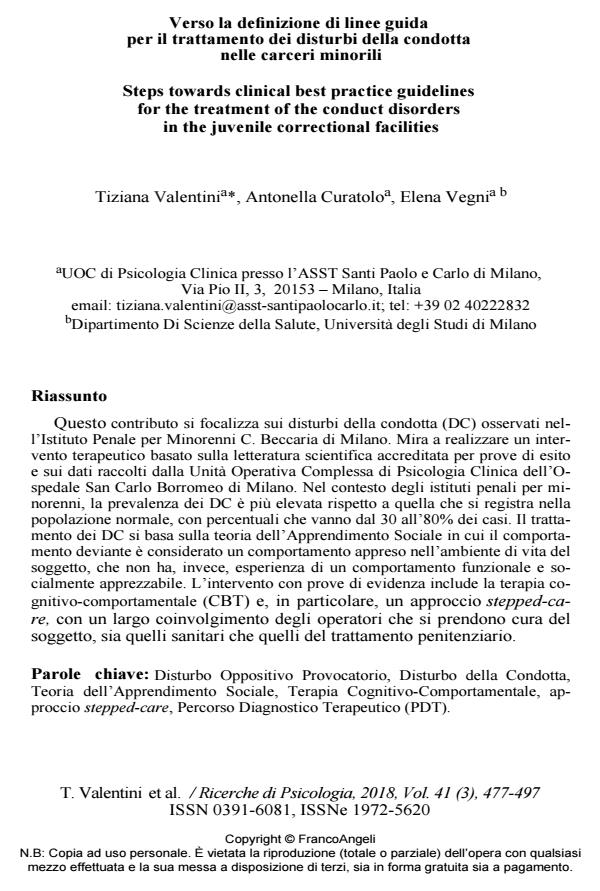Steps towards clinical best practice guidelines for the treatment of the conduct disorders in the juvenile correctional facilities
Journal title RICERCHE DI PSICOLOGIA
Author/s Tiziana Valentinia, Antonella Curatoloa, Elena Vegnia
Publishing Year 2018 Issue 2018/3 Language Italian
Pages 21 P. 477-197 File size 96 KB
DOI 10.3280/RIP2018-003010
DOI is like a bar code for intellectual property: to have more infomation
click here
Below, you can see the article first page
If you want to buy this article in PDF format, you can do it, following the instructions to buy download credits

FrancoAngeli is member of Publishers International Linking Association, Inc (PILA), a not-for-profit association which run the CrossRef service enabling links to and from online scholarly content.
The present contribution focuses on the conduct disorders (CD) observed in the C. Beccaria Juvenile correctional facility of Milan. It aims at implementing a therapeutic intervention, starting from evidence based literature and from data which were gathered at the Clinical Psychology Unit of San Carlo Hospital, Milan, Italy. In the context of juvenile correctional facilities, CD prevalence is significantly higher than that in the normal population, with a range of 30 to 80% of cases. CD treatment is based on social learning theory where a deviant behavior is seen as a knowledge learned in the living environment of the subject, since a functional and socially rewarded behavior is lacking. Evidence based intervention includes Cognitive Behavioral Therapy (CBT) and, in particular, a stepped based care with a large involvement of the team of care-givers inside and outside the clinical setting.
Keywords: Oppositional Defiant Disorders, Conduct Disorder, Social Learning Theory, Cognitive-Behavioral Therapy, Stepped-Care, Diagnostic-Therapeutic Path
- American Psychiatric Association (APA) (2014). DSM-5. Milano: Raffaello Cortina.
- Bandura, A. (1977). Social Learning Theory. Englewood Cliffs, N.J: Prentice-Hall.
- Calderoni, D., Cirigliano, L., Farruggia, R., Levi G., & Romani, M. (2010). Il disturbo borderline della personalità in età evolutiva. Roma: Fioriti.
- Dimaggio, G., Montano, A., Popolo, R., & Salvatore, G. (2013). Terapia Meta cognitiva Interpersonale dei disturbi di personalità. Milano: Raffaello Cortina.
- Dazzi, S., & Madeddu, F. (2009) Devianza e antisocialità. Milano: Raffaello Cortina.
- Gale, B.M. (2011). Oppositional defiant disorders. In W.T. O’Donohue e C. Draper (Eds.), Stepped care and e-Health. Practical Applications to Behavioral Disorders. New York: Springer.
- Giampieri, E., & Clerici, M., (2013) Il suicidio oggi. Implicazioni sociali e psicopatologiche. Berlino: Springer Verlag.
- Goldstein, P.A., Glick, B., & Gibbs, C.J. (1998). Aggression Replacement Training. Revised Edition. USA: McNaughton, Gunn, Inc.
- Goldstein, M.L., & Morewitz, S. (2011). Chronic Disorders in Children and Adolescents. Cham: Springer.
- Humayun, S., & Scott, S. (2015). Evidence-Based Interventions for Violent Bahavior in Children and Adolescent. In J. Lindert & I. Levav (Eds.), Violence and Mental Health (pp. 391-419). DOI: 10.1007/978-94-017-8999-8_18
- Kernberg, P.F., Weiner, A.S., & Bardenstein, K.K. (2001). I disturbi di personalità nei bambini e negli adolescenti. Roma: Giovanni Fioriti.
- Kalafat, J. (2005). Suicide. In T.P. Gullotta & G.R. Adams, Handbook of adolescent behavioral problems. Evidence-Based Approaches to Prevention and Treatment (pp. 231-254). Switzerland: Springer.
- Organizzazione Mondiale della Sanità (OMS) (1994). ICD-10 Classificazione delle sindromi e dei disturbi psichici e comportamentali. Milano: Masson.
- Muratori, F. (2005). Ragazzi violenti. Bologna: il Mulino. Prochaska, J.O., & Di Clemente, C.C. (1982). Transtheoritical therapy. Toward a more integrative model of change. Psychotherapy: Theory, Research and Practice, 19, 276-288.
- Rezzonico, G.F. (1989). Aspetti della sindrome pre-suicidaria e principi di intervento. Tribuna Medica del Ticino, 54, 63-70.
- Saita, E., & Pagano, L. (2018). Là, dove i mari si toccano: la psicologia nel sistema di esecuzione della pena. Ricerche di Psicologia, 3, 299-305.
- Thompson, C.K., & Morris, J.R. (2016). Juvenile Delinquency and Disability. Switzerland: Springer.
- Tolan, P.T., & Levental, B.L. (2013). Disruptive Behavior Disorders. New York: Springer.
- Velotti, P. (2015). Comprendere il male. Il disturbo antisociale di personalità. Bologna: il Mulino.
- Young, J.E., Klosko, J.S., & Weishaar, E.M. (2007). Schema Therapy. La terapia cognitivo-comportamentale integrata per I disturbi della personalità. Firenze: Eclipsi.
- Wong, S.C.P. (2017). Il trattamento delle persone inclini alla violenza con tratti psicopatici di personalità. In W.J. Livesly, G. Dimaggio, & J.F. Clarkin (Eds.), Trattamento integrato per i disturbi di personalità. Un approccio modulare (pp. 371-400). Milano: Raffaello Cortina.
Tiziana Valentinia, Antonella Curatoloa, Elena Vegnia, Verso la definizione di linee guida per il trattamento dei disturbi della condotta nelle carceri minorili in "RICERCHE DI PSICOLOGIA " 3/2018, pp 477-197, DOI: 10.3280/RIP2018-003010